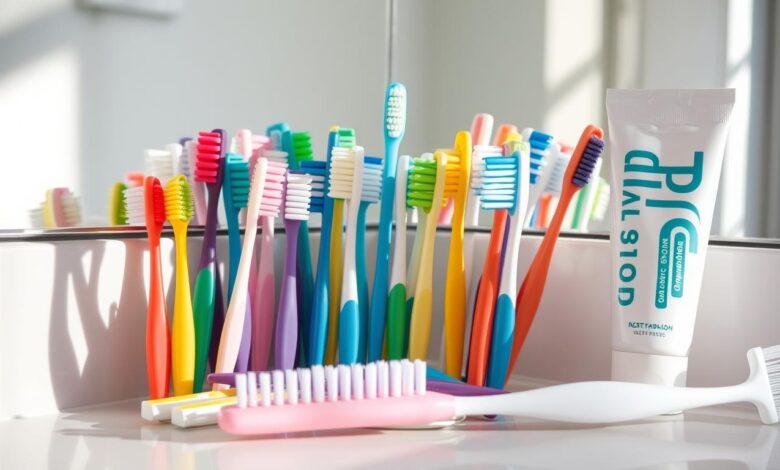The Ultimate Guide to Choosing the Right Toothbrush

Are you tired of struggling with ineffective oral hygiene? Constantly searching for the perfect toothbrush can be frustrating. This comprehensive guide is here to help you find the right toothbrush for your needs.
Learn about the differences between manual and electric toothbrushes. Understand the importance of bristle types and how to choose a handle design for comfort and effectiveness. Get ready to improve your dental care routine and keep your smile healthy and radiant.
Key Takeaways
- Choosing the right toothbrush is essential for optimal oral hygiene and dental health
- Understanding the features and differences between manual and electric toothbrushes can help you make an informed decision
- Bristle types (soft, medium, or hard) play a crucial role in effective plaque removal and gum health
- Handle design and grip comfort can significantly impact the ease and effectiveness of your brushing routine
- Consulting with your dentist can provide valuable insights and recommendations for your specific oral hygiene needs
Understanding Toothbrush Types and Features
The type of toothbrush you use can greatly affect your dental health. There are mainly two types: manual and electric. Both aim to remove plaque and keep gums healthy, but they work differently.
Manual vs. Electric Toothbrushes
Manual toothbrushes need you to move them to clean your teeth. This requires more effort from you. On the other hand, electric toothbrushes use batteries for a deeper clean. They come in oscillating-rotating and sonic types. Oscillating-rotating brushes move back and forth, while sonic ones vibrate to clean better.
Choosing between manual and electric depends on your needs. Electric toothbrushes clean better, especially for those with a lot of plaque or limited mobility. They offer a deeper clean.
Bristle Types: Soft, Medium, or Hard
Toothbrush bristles are soft, medium, or hard. Soft bristles are gentle, perfect for sensitive teeth and gums. Medium bristles balance cleaning and gentleness. Hard bristles are too rough and can harm your gums and teeth.
Soft bristles are safest for daily use. Brush gently, no matter the bristle type. Replace your toothbrush every three to four months or sooner if the bristles wear out.
Factors to Consider When Selecting a Toothbrush
Choosing the right toothbrush is key to good oral hygiene. If you have gum disease or are getting orthodontic treatment, you need a special toothbrush. This is because you need to clean around braces or reach hard-to-get areas.
People with a lot of plaque or sensitive teeth should look for a toothbrush with a small head and soft bristles. This helps clean well without hurting your teeth or gums.
Oral Hygiene Needs and Dental Conditions
It’s important to talk to your dentist about the best toothbrush for you. They can suggest the right type and features based on your dental health. They consider things like:
- Gum disease: A toothbrush with a small head and soft bristles can gently clean around inflamed gums.
- Orthodontic treatment: A toothbrush with a specialized shape or angled bristles can help clean around braces and other orthodontic appliances.
- Plaque buildup: A toothbrush with a larger head and medium-to-firm bristles may be more effective at removing stubborn plaque.
- Sensitive teeth: A toothbrush with soft bristles can clean your teeth without causing discomfort.
Handle Design and Grip Comfort
The design and comfort of the toothbrush handle are also important. An ergonomic handle makes it easy to hold and move the toothbrush. This is great for people with dexterity challenges or arthritis.
Look for toothbrushes with handles that fit your hand well. They should be textured or contoured for a secure grip. This makes brushing more effective and comfortable.
Visit LivHealthy Dental blog for more dentistry tips and advice on choosing the right toothbrush for your needs.
A Guide to Choosing the Right Toothbrush
Choosing the right toothbrush is key for good oral health. You might prefer a manual or electric toothbrush. Knowing the features and benefits helps you decide. Let’s look at what to consider when picking your next toothbrush.
Manual vs. Electric Toothbrushes
Manual toothbrushes are classic and affordable. Electric toothbrushes offer better cleaning. They come in types like rotating, oscillating, and sonic. Sonic toothbrushes vibrate fast, cleaning your teeth well.
Bristle Types: Soft, Medium, or Hard
The bristle type affects your oral health. Dentists suggest soft-bristle brushes for gentle cleaning. Medium and hard bristles can harm your teeth and gums.
Handle Design and Grip Comfort
The toothbrush handle’s design matters too. Choose one that’s easy to hold and use. Some brushes have sensors to prevent too much pressure.
Think about your oral health needs and dental conditions when picking a toothbrush. Your dentist can give advice for the best choice for you.
Finding the right toothbrush helps keep your teeth and gums healthy. For more dental tips, check out the LivHealthy Dental blog.
“Replacing your toothbrush every three to four months is recommended for optimal oral hygiene and dental health.”
Conclusion
Choosing the right toothbrush is key to good oral hygiene and dental health. Knowing the different types and their features helps you pick the best one. Whether you like manual or electric toothbrushes, the right one can greatly improve your dental care.
Don’t forget to talk to your dentist for advice. Also, check out the LivHealthy Dental blog for more tips on keeping your mouth healthy. With the right toothbrush and good dental care, you can have healthy teeth and gums for life.
When you choose a toothbrush wisely, you’re taking a big step towards better oral health. Look at your options, think about what you need, and pick a toothbrush that makes your smile shine.
FAQ
What are the main types of toothbrushes?
There are two main types of toothbrushes: manual and electric. Manual toothbrushes need your hand to clean your teeth. Electric toothbrushes use batteries for a deeper clean.
What are the different bristle types for toothbrushes?
Toothbrush bristles come in soft, medium, and hard types. Soft bristles are gentle on your gums and teeth. Medium bristles offer a balanced clean. Hard bristles can harm your gums and tooth enamel.
How do I choose the best toothbrush for my oral health needs?
Think about your oral hygiene needs and any dental conditions. Talk to your dentist to find the best toothbrush for you.
What should I look for in the handle design of a toothbrush?
The handle’s design and comfort are key. Choose toothbrushes with handles that fit your hand well. This ensures a better brushing experience.
How can I ensure I’m choosing the right toothbrush for my dental health?
The best way is to talk to your dentist. They can suggest the right toothbrush based on your dental health.



